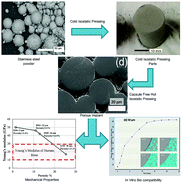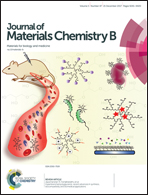Stainless steel with tailored porosity using canister-free hot isostatic pressing for improved osseointegration implants
Abstract
Porous biomedical implants hold great potential in preventing stress shielding while improving bone osseointegration and regeneration. In this paper, a novel approach is introduced to control the porosity of 316L stainless steel implants by using canister-free hot isostatic pressing (CF-HIPing). The proposed approach uses cold isostatic pressing (CIPing) to generate powder compacts with various particle sizes, followed by CF-HIPing. 316L stainless steel samples with controlled porosity, and mechanical and biological properties were successfully achieved. The results showed a significant increase in the samples’ porosity with increasing powder size. Porous structures with a strength of 108–360 MPa, Vickers hardness of 25–49 HV and elastic modulus between 17 and 50 GPa were produced using a particle size range of 5–50 μm. The effect of samples with various porosities on the in vitro response of mouse pre-osteoblastic cells in terms of toxicity and proliferation was studied. All samples showed that they had a minimal toxic effect on the osteoblasts. Samples with low porosity, prepared using a particle size of 5 μm, were believed to hinder the transport of nutrients and oxygen to the cells and hence had lower proliferation. In addition, samples prepared using a particle size range of 16–50 μm were associated with an increased proliferation and are therefore expected to improve the rate of bone osseointegration.



 Please wait while we load your content...
Please wait while we load your content...